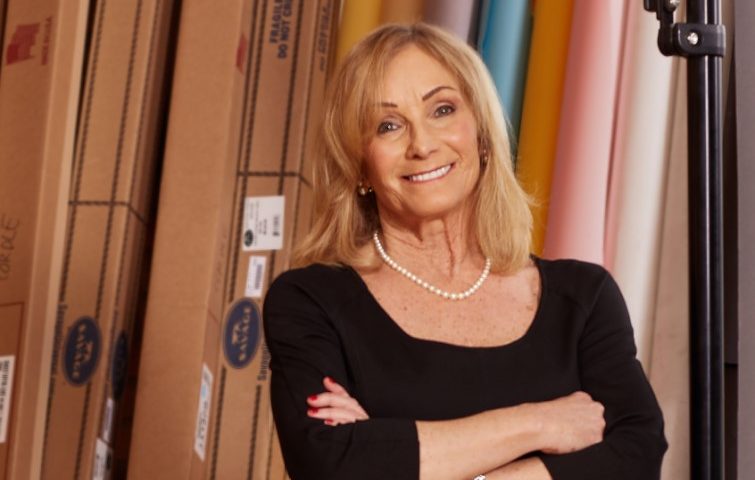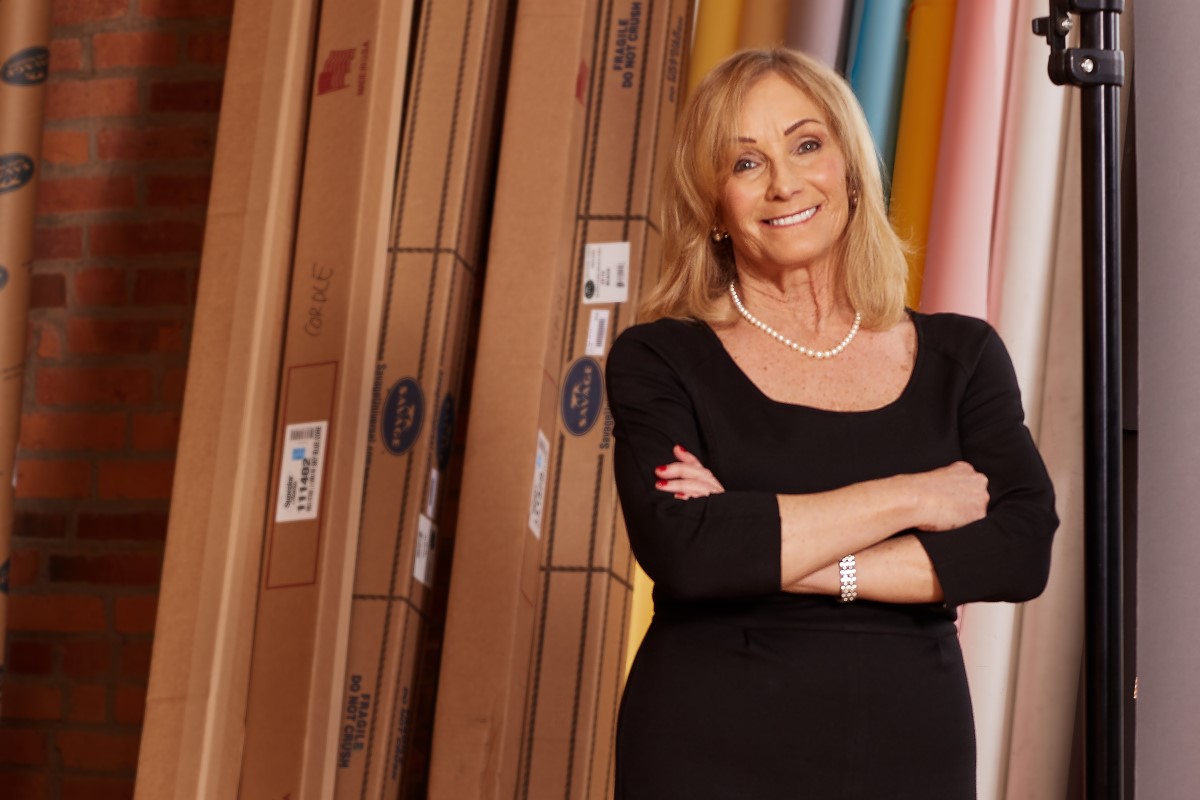Tobi Furman Launched The Artmobile to Combine her Love of Art with her Passion for Community


Photo by Matt Reese
[spp-player]
Interview by Sarah Shumick
As the former senior vice president for marketing at United Way of Central Ohio, Tobi Furman was “acutely aware of the increasing poverty and disparities that many students in our community face, academically and culturally.” She started The Artmobile in 2016 and saw an opportunity to combine her love for the arts with her desire to improve the quality of life for underserved children. In the summer of 2017, The Artmobile program launched in Hilltop and Franklinton as an “affordable and innovative way to deliver high quality, arts inspired learning experiences to at-risk children ages 5-14 living in underserved neighborhoods where access and exposure to the arts and art education is very limited,” shares Furman. Arts professionals staff The Artmobile, something Furman says is vital to the quality of the artistic experience for the young people they serve.
Name: Tobi Furman
Age: 63
Profession: Founder and Program Director / Visual Artist, The Artmobile
Connect: LinkedIn | Facebook | Instagram
Give us a brief overview of your organization: The mission of The Artmobile is to enrich the lives of students by providing high quality, after school and summer arts programs with hands-on, culturally-enriching activities for youth in the communities where it is needed most and with a curriculum designed and taught by artists and arts educators
The Artmobile Program, an arts studio on wheels, is a no-cost or low-cost program that offers a convenient and economical way to provide access and exposure to arts inspired learning for underserved populations. As K-12 programs continue to face increasing economic pressures and subsequent budget cuts that often affect arts programs, the Artmobile Program can help fill the void. In addition to teaching artists and art educators, our staff includes a program director, assistant and volunteers.
What population does it serve? In just two years, The Artmobile has served more than 1,800 youth through its summer learning and after school programming. The team believes that all young people should have the opportunity to benefit from the creativity, fun and self-confidence that comes from a well-structured mobile arts and art education program, particularly in struggling neighborhoods where access and exposure to the arts and art education is very limited.
Studies show that young people who actively participate in an art program perform better in school, have higher attendance rates, are more likely to take leadership roles, and are more likely to attend college.
How you are innovating in the nonprofit space? Many people are familiar with bloodmobiles, mobile blood donation centers, and bookmobile that foster a love of learning and reading by bringing books into local neighborhoods. These programs served as the inspiration for The Artmobile. Traditionally, participants are expected to go to a location to engage in arts activities. Instead, the Artmobile brings these opportunities to where students live and gather. This simple but effective shift makes this a strong solution to broaden access and exposure to the arts and art education for at-risk youth. By being mobile, the Artmobile can provide flexible, cost-effective and creative solutions to fill in the gap through art making experiences that ignite the imagination and lead students to discover their own creativity, passion, talents and abilities.
How is your organization making an impact in Columbus? The Artmobile goes where it’s needed most and makes arts-inspired learning opportunities accessible to all youth despite their socio-economic background. We are making an impact in our neighborhoods by being mobile. We are a transportation solution since many neighborhoods lack access and exposure to arts and art education programming and face many transportation limitations. To date, we have enriched the lives of 1,850 students with high quality arts inspired learning activities that opens up creative possibilities and adventurous problem-solving for students living in low income neighborhoods who might otherwise not have access to the arts. At the end of every art making session we hand out a short survey. Arts fans who attended our session and participated in the survey said 93% had fun, 87% want to come back and 82% learned something new.
What makes your organization thrive? The passion we put into our work. The joy that we see in our students as they learn to express themselves through a creative medium that knows no boundaries.
As a leader, how do you come up with innovative ideas, and what helps put those ideas into action? I have adopted many practices from my former career as a marketing executive, including conducting best practice research, trends analysis and participant feedback. Most importantly, we listen to nonprofits we work with, the students we teach and the arts educators who help us bring engaging, enriching arts programming to life. Our innovations are the result of a collaborative process involving local artists, art agencies, art educators and community leaders.
Give us a snapshot of your career path—what is your background, and what led you to work in the nonprofit sector? I have always had a love of the arts and a passion for helping others. I have been fortunate to have the opportunity to pursue both in my professional and personal life. In addition to my senior leadership role at United Way, I am past president of the National Council of Jewish Women Columbus, former Resource Development Director for Jewish Family Services, have served on a variety of nonprofit boards, and have mentored youth and volunteered to provide art supplies and assistance to families in homeless shelters. The Artmobile is a natural progression for me that leverages my experience, interests and passion. I am an alumnus of Syracuse University and a graduate of Leadership Columbus. I currently serve on the Board of Directors for Columbus Early Learning Centers and Citizens Advisory Council of Franklin County Children Services. I was named “2009 Superstar, Marketing and Sales” by Columbus CEO Magazine.
What is the one thing you are most passionate about? Helping students and campers reach their full potential through arts inspired learning opportunities. There is nothing like a student looking at me and saying with an excitement: “Ms. Tobi – I finished my project!” That sense of pride is really empowering for them.
What inspires you? I regularly visit museums, attend subject conferences, concerts, arts exhibits, gallery openings, theater and dance productions. The arts fill my family life and inspire me professionally.
How do you stay motivated? What drives you to take things to the next level? The feedback that we have received from community organizations that have participated in our programs has been very positive. However, helping students explore themselves and the world around them through the creative process continues to sustain my commitment to The Artmobile.
What struggles or adversities have you had to overcome to get to where you are today? As a young girl in public school, I suffered through many classes in reading and writing. I often found myself struggling and feeling inadequate which led to low self-esteem and confidence. When I was 15, my parents took me to Hofstra University in Long Island, NY to get analyzed for a learning disability. I went through strenuous eye exercises for 6 months (which at the time was all they could offer). I was entering high school and began participating in an arts program that help me understand that I was more of a visual learner and this helped me get through school. I graduated from Syracuse University as an architect. By then I had developed coping skills, worked very hard throughout my career and was successful. Fast forward 30 years later and I finally had enough courage to get properly evaluated. My diagnosis was moderate Dyslexia – which didn’t shock me. Reconciling with myself about this now named learning disability drove me to want to help other kids that struggle in reading and writing but don’t know why. My “aha” moment was when I decided to develop a mobile arts outreach program that would deliver more than just art because the curriculum revolves around STEAM.
Why do you think people should care about innovative nonprofits? Nonprofit organizations need innovation every bit as much as for-profit companies. They need it more because they lack the resources and cash flow of large companies. They have to be nimbler and more opportunistic in achieving their mission. Some of that innovation results in new programs like The Artmobile. Some of it comes from fee for service programs that enable nonprofits to create new revenue streams.
Small startups can have an advantage over larger organizations because they are not locked into a management structure or silos, so they can think differently about problems and solutions. Smaller startup nonprofits can do the same.
As a kid, what did you say you wanted to be when you grew up? I wanted to be a successful women in business no matter what it took.
What might others be surprised to know about you? While living in NYC I worked in an advertising agency that had the Wendy’s business. I worked on the Wendy’s account for 10 years and was instrumental in producing the award-winning, longest running fast food advertising campaign featuring Wendy’s founder Dave Thomas. Knowing Dave Thomas for 10 years introduced me to the world of adoption and as a result I adopted twin boys in January of 2000. My sons are now freshmen at Kent State University.
How can others in the Columbus community get involved with your organization? We welcome volunteers when we participate in neighborhood events, organizing an art supply drive at a company, and investing in the work we do with our students/campers at cbusartmobile.org.
If someone were to ask you what the “pulse” of Columbus is, what would you tell them? There is an innate creative spirit that thrives in Columbus. You don’t really expect it from a Midwestern city. And, it is not just about the arts, it’s about every facet of community. I think it’s a community that never says no and instead is willing to ask “How can we do that?”

